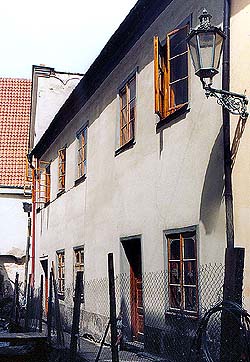Šatlavská No. 142
Description of the Building:
One-storey building with a smooth facade on a large allotment. On
the street side ground floor and first floor are two lateral wings
with barrel Renaissance vaults. Through the left part was
originally a passage into a small yard, which led from a
semicircular staircase upstairs. On the first floor is a barrel
vaulted hall with sections, and the other areas have flat ceilings.
The cellars repeat the two wing ground floor layout. Located by the
rear facade are three Gothic barrel vaulted rooms on the level of
the rear part landscape.
Architectural and Historical Development:
The building is of Gothic origin. The rear layout on the bottom
level was preserved. The house was adapted during Renaissance. This
adaptation changed the basic layout only a little. Completion of
the layout occurred evidently in Classicism.
History of the House Residents:
At the beginning of the 16th century, the house was occupied by
Matěj Fitka and his wife. After Matěj died, the house was acquired
by a beneficiary Šimek. He sold it to a malt maker, Prokeš
(Prokop), most of the time called "a malt maker under the
rathouse", in 1514. After he died in 1566, his son Jiří sold the
house with the approval from his mother Barbora to a blacksmith,
Mikuláš Ebenauer, who resided in the house with his wife, Mariana.
Mikuláš died in 1573. A tailor Kryštof became the next owner. After
he died his widow, Magdalena, sold the house to a tin maker, Jošt,
in 1582. In 1587 Dorota Mitasová bought the house, and in 1591 sold
it to a baker, Erhart Silbermann, who moved into the house from
Šatlavská
No. 140. In 1598 a bricklayer, Hans Hás, called also Vlach,
bought the house. He was most probably a brother of an Italian
bricklayer, Benedikt Penny, from the house Masná
No. 128. Voršila Hásová lived in the house until 1636 when he
was replaced by a organist, Martin Perger. In 1685 the house
belonged to an auditor of the princely artillery, Kašpar Mayer, who
was replaced by a princely ammunition maker, Jan Schmidt. During
1699 - 1734 a court carpenter, Jiří Hans, lived there. From 1784
until the middle of the 19th century the house belonged to the
Mauder family.
Present Use:
Art gallery


